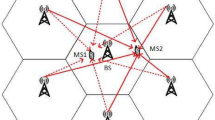Abstract
Traditional cellular networks require the downlink (DL) and uplink (UL) of mobile users (MUs) to be associated with a single base station (BS). However, the power gap between BSs and MUs in different transmission environments results in the BS with the strongest downlink differing from the BS with the strongest uplink. In addition, the significant increase in the number of wireless machine type communication (MTC) devices accessing cellular networks has created a DL/UL traffic imbalance with higher traffic volume on the uplink. In this paper, a joint user association and resource partition framework for downlink-uplink decoupling (DUDe) is developed for a tiered heterogeneous cellular network (HCN). Different from the traditional association rules such as maximal received power and range extension, a coalition game based scheme is proposed for the optimal user association with DUDe. The stability and convergence of this scheme are proven and shown to converge to a Nash equilibrium at a geometric rate. Moreover, the DL and UL optimal bandwidth partition for BSs is derived based on user association considering fairness. Extensive simulation results demonstrate the effectiveness of the proposed scheme, which enhances the sum rate compared with other user association strategies.
Similar content being viewed by others
References
Andrews, J.G., 2013. Seven ways that HetNets are a cellular paradigm shift. IEEE Commun. Mag., 51(3): 136–144. http://dx.doi.org/10.1109/MCOM.2013.6476878
Boccardi, F., Andrews, J., Elshaer, H., et al., 2016. Why to decouple the uplink and downlink in cellular networks and how to do it. IEEE Commun. Mag., 54(3): 110–117. http://dx.doi.org/10.1109/MCOM.2016.7432156
Brémaud, P., 1999. Markov Chains: Gibbs Fields, Monte Carlo Simulation, and Queues. Springer-Verlag, New York, NY.
Dhillon, H.S., Ganti, R.K., Baccelli, F., et al., 2012. Modeling and analysis of k-tier downlink heterogeneous cellular networks. IEEE J. Sel. Areas Commun., 30(3): 556–560. http://dx.doi.org/10.1109/JSAC.2012.120405
Dhillon, H.S., Ganti, R.K., Andrews, J.G., 2013. Loadaware modeling and analysis of heterogeneous cellular networks. IEEE Trans. Wirel. Commun., 12(4): 1666–1677. http://dx.doi.org/10.1109/TWC.2013.13.120485
ElSawy, H., Hossain, E., Haenggi, M., 2013. Stochastic geometry for modeling, analysis, and design of multitier and cognitive cellular wireless networks: a survey. IEEE Commun. Surv. Tutor., 15(3): 996–1019. http://dx.doi.org/10.1109/SURV.2013.052213.00000
Elshaer, H., Boccardi, F., Dohler, M., et al., 2014. Downlink and uplink decoupling: a disruptive architectural design for 5G networks. Proc. IEEE Globecom, p.1798–1803. http://dx.doi.org/10.1109/GLOCOM.2014.7037069
Feng, Z., Feng, Z., Li, W., et al., 2014. Downlink and uplink splitting user association in two-tier heterogeneous cellular networks. Proc. IEEE Globecom, p.4659–4664. http://dx.doi.org/10.1109/GLOCOM.2014.7037543
Fooladivanda, D., Rosenberg, C., 2013. Joint resource allocation and user association for heterogeneous wireless cellular networks. IEEE Trans. Wirel. Commun., 12(1): 248–257. http://dx.doi.org/10.1109/TWC.2012.121112.120018
Ge, X., Tu, S., Mao, G., et al., 2016. 5G ultra-dense cellular networks. IEEE Wirel. Commun., 23(1): 72–79. http://dx.doi.org/10.1109/MWC.2016.7422408
Jiang, L., Sha, X., Wu, X., et al., 2016. A novel resource allocation algorithm based on downlink and uplink decouple access scheme in heterogeneous networks. China Commun., 13(6): 1673–5447. http://dx.doi.org/10.1109/CC.2016.7513200
Jo, H.S., Sang, Y.J., Xia, P., et al., 2012. Heterogeneous cellular networks with flexible cell association: a comprehensive downlink SINR analysis. IEEE Trans. Wirel. Commun., 11(10): 3484–3495. http://dx.doi.org/10.1109/TWC.2012.081612.111361
Li, Y., Jin, D., Yuan, J., et al., 2014. Coalitional games for resource allocation in the device-to-device uplink underlaying cellular networks. IEEE Trans. Wirel. Commun., 13(7): 3965–3977. http://dx.doi.org/10.1109/TWC.2014.2325552
Lien, S., Chen, K., Lin, Y., 2011. Toward ubiquitous massive accesses in 3GPP machine-to-machine communications. IEEE Commun. Mag., 49(4): 66–74. http://dx.doi.org/10.1109/MCOM.2011.5741148
López-Pérez, D., Güvenc, İ., Roche, G., et al., 2011. Enhanced intercell interference coordination challenges in heterogeneous networks. IEEE Wirel. Commun., 18(3): 22–30. http://dx.doi.org/10.1109/MWC.2011.5876497
Madan, R., Borran, J., Sampath, A., et al., 2010. Cell association and interference coordination in heterogeneous LTE-A cellular networks. IEEE J. Sel. Areas Commun., 28(9): 1479–1489. http://dx.doi.org/10.1109/JSAC.2010.101209
Nesterov, Y., Nemirovski, A., 1994. Interior point polynomial time methods in convex programming. In: SIAM Studies in Applied Mathematics. Philadelphia, PA.
Saad, W., Han, Z., Hjørungnes, A., 2011. Coalitional games for cooperative wireless cellular networks. In: Hossain, E., Kim, D., Bhargava, V. (Eds.), Cooperative Cellular Wireless Networks. Cambridge University Press.
Singh, S., Baccelli, F., Andrews, J.G., 2014. On association cells in random heterogeneous networks. IEEE Wirel. Commun. Lett., 3(1): 70–73. http://dx.doi.org/10.1109/WCL.2013.111713.130707
Singh, S., Zhang, X., Andrews, J.G., 2015. Joint rate and SINR coverage analysis for decoupled uplink-downlink biased cell associations in HetNets. IEEE Trans. Wirel. Commun., 14(10): 5360–5373. http://dx.doi.org/10.1109/TWC.2015.2437378
Smiljkovikj, K., Popovski, P., Gavrilovska, L., 2015. Analysis of the decoupled access for downlink and uplink in wireless heterogeneous networks. IEEE Wirel. Commun. Lett., 4(2): 173–176. http://dx.doi.org/10.1109/LWC.2015.2388676
Son, K., Kim, H., Yi, Y., et al., 2011. Base station operation and user association mechanisms for energy-delay tradeoffs in green cellular networks. IEEE J. Sel. Areas Commun., 29(8): 1525–1536. http://dx.doi.org/10.1109/JSAC.2011.110903
Yang, C., Li, J., Guizani, M., 2016. Cooperation for spectral and energy efficiency in ultra-dense small cell networks. IEEE Wirel. Commun., 23(1): 64–71. http://dx.doi.org/10.1109/MWC.2016.7422407
Ye, Q., Rong, B., Chen, Y., et al., 2013. User association for load balancing in heterogeneous cellular networks. IEEE Trans. Wirel. Commun., 12(6): 2706–2716. http://dx.doi.org/10.1109/TWC.2013.040413.120676
Author information
Authors and Affiliations
Corresponding author
Additional information
Project supported by the National High-Tech R&D Program (863) of China (No. 2015AA01A705) and the National Natural Science Foundation of China (No. 61525101)
ORCID: Zhi-yong FENG, http://orcid.org/0000-0001-5322-222X
Rights and permissions
About this article
Cite this article
Feng, Zy., Feng, Zb. & Gulliver, T.A. Joint user association and resource partition for downlink-uplink decoupling inmulti-tier HetNets. Frontiers Inf Technol Electronic Eng 18, 817–829 (2017). https://doi.org/10.1631/FITEE.1700031
Received:
Revised:
Accepted:
Published:
Issue Date:
DOI: https://doi.org/10.1631/FITEE.1700031
Key words
- Downlink-uplink decoupling
- User association
- Resource partition
- Heterogeneous cellular network
- Coalition game




